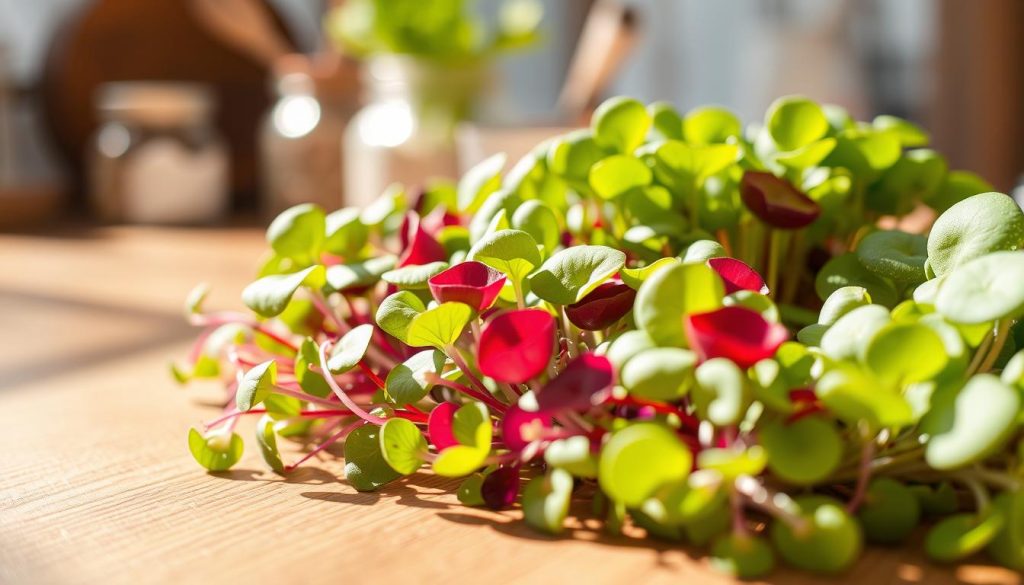Microgreens: Surprising Health Benefits You Need to Know
Explore the amazing world of microgreens, tiny greens that are nutritional powerhouses. They have changed the way we eat since they first appeared in California’s fancy restaurants in the 1980s. These small greens offer a huge boost of health benefits that can change how you think about food.
Microgreens are only 1-3 inches tall and are picked 7-21 days after they start growing. What’s amazing is that they have a lot of vitamins and minerals, sometimes up to 40 times more than full-grown veggies. This makes them a superfood in the world of microgreens nutrition.
Unlike regular veggies, these tiny greens have a strong taste and lots of health benefits. They’re not just for decoration; they’re a real nutritional boost that can help your health in many ways.
Key Takeaways
- Microgreens contain up to 40 times more nutrients than mature vegetables
- Harvested within 7-21 days of sprouting
- Originated in California restaurants in the 1980s
- Exceptionally high in vitamins and minerals
- Easy to grow at home or find in local markets
What Are Microgreens and Where Do They Come From?
Microgreens are tiny plants full of nutrients. They’re not just for decoration; they’re packed with health benefits. Scientists around the world are studying their nutritional value.
Understanding Microgreen Basics
Microgreens are young greens harvested when they’re about 1-3 inches tall. They grow fast, in just 7-21 days. Unlike sprouts, they grow in soil and have more mature flavors.
Diverse Types of Microgreens
- Radish microgreens
- Broccoli microgreens
- Sunflower microgreens
- Kale microgreens
- Pea shoot microgreens
Nutritional Roots of Microgreens
Microgreens are incredibly nutritious. They can have up to nine times more nutrients than full-grown veggies. Some studies show they have 40 times more vitamins and antioxidants than their mature versions.
There are about 60 different types of microgreens. They’re easy to grow all year, even in small spaces. This makes them a great choice for anyone looking to eat healthier.
A Nutrient Powerhouse: Vitamins and Minerals
Microgreens are tiny nutrition powerhouses. They pack a big punch of vitamins and minerals. These small greens are not just for decoration. They are a concentrated source of essential nutrients that can boost your diet.
The vitamins in microgreens are amazing. Studies show these tiny plants have much more nutrients than full-grown greens. For example:
- Red cabbage microgreens have 40 times more vitamin E than mature cabbage
- Arugula microgreens provide 45.8 mg of vitamin C per 100 grams
- Pea shoot microgreens contain 1.5 times more vitamin C than regular peas
Vitamin Content in Microgreens
Different microgreen varieties have unique vitamin profiles. Some standouts include:
- Cilantro: Excellent source of Vitamin A
- Garnet amaranth: Rich in Vitamin K
- Green daikon radish: High in Vitamin E
Essential Minerals Found in Microgreens
Microgreens are also mineral powerhouses. They have high levels of potassium, iron, zinc, magnesium, and copper. These minerals are key for health, from strong bones to a strong immune system.
With their high nutrient density, microgreens are a great way to increase your daily vitamins and minerals. Whether on salads or in smoothies, these tiny greens can greatly improve your nutrition.
Antioxidant Properties of Microgreens
Microgreens are tiny green shoots full of nutrients. They have amazing antioxidant health properties. These tiny greens protect our body from damage at the cellular level.
Let’s explore how microgreens fight off harmful free radicals. Free radicals are unstable molecules that can harm our cells. This can lead to chronic diseases.
What Are Antioxidants?
Antioxidants are natural compounds that fight free radicals. They act like tiny defenders, protecting our cells from damage. Microgreens are rich in these protective molecules.
How Microgreens Combat Free Radicals
- Microgreens contain up to 40 times more nutrients than mature plant leaves
- They provide concentrated antioxidant protection in small serving sizes
- Different microgreen varieties offer unique antioxidant profiles
Research shows microgreens can help prevent chronic diseases. Their high nutrient content makes them great for a healthy diet. Adding these greens to your meals can help reduce oxidative stress and support cell health.
The health benefits of microgreens go beyond just nutrition. Studies indicate they may prevent heart disease, diabetes, and some cancers. This is thanks to their strong antioxidant properties.
Heart Health Benefits of Microgreens
Microgreens are becoming a big deal for heart health. They are tiny but full of nutrients that help keep your heart strong. Adding them to your diet can make a big difference in protecting your heart.

Studies show that microgreens are great for your heart. They are full of antioxidants and important nutrients. This makes them a natural way to support your heart’s health.
Cholesterol Management Through Microgreens
Microgreens can help manage cholesterol levels. Research shows that some types of microgreens can:
- Reduce triglyceride levels
- Lower “bad” LDL cholesterol
- Increase protective antioxidant intake
Cardiovascular Support from Specific Microgreen Varieties
Each type of microgreen offers its own heart health benefits:
- Broccoli microgreens: Rich in sulforaphane, which helps protect against heart disease
- Radish microgreens: Contains omega-3 fatty acids supporting heart health
- Red cabbage microgreens: Delivers concentrated nutrients beneficial for cardiovascular function
The USDA says microgreens have four to six times more nutrients than regular veggies. They are a great choice for a heart-healthy diet.
Microgreens and Gut Health: A Connection
Digestive wellness is key to overall health. Microgreens are tiny powerhouses that support gut health. They are packed with nutrients that help your digestive system.
Fiber Content in Microgreens
Microgreens are a fiber powerhouse. Adults need 25 grams of fiber a day. Microgreens can help you reach this goal. They are full of dietary fiber that aids digestion.
- Support regular bowel movements
- Feed beneficial gut bacteria
- Reduce inflammation in the digestive tract
Microgreens’ Role in Digestive Wellness
Microgreens also support the gut microbiome. Studies show our gut has about 200 different microorganisms. These greens help keep our gut microbiome balanced, which can lower digestive disorder risks.
The enzyme myrosinase in microgreens turns nutrients into sulforaphane. This antioxidant boosts digestive health. Adding microgreens to your diet may help prevent digestive issues and reduce inflammation.
Microgreens have up to 40 times more nutrients than mature veggies. They are a simple yet effective way to support a healthy gut.
Microgreens as a Natural Anti-Inflammatory
Inflammation is a complex response in our bodies. It helps protect us but can cause harm if it lasts too long. Research on microgreens shows they might help fight this ongoing health issue.
To understand inflammation, we must see its role in our defense. But too much of it can lead to problems like arthritis and heart disease.
Anti-Inflammatory Microgreen Powerhouses
Some microgreens are especially good at fighting inflammation. The top ones include:
- Broccoli microgreens: Rich in sulforaphane, which helps combat inflammatory responses
- Red cabbage microgreens: Contains high levels of anthocyanins that reduce inflammation
- Kale microgreens: Packed with antioxidants that neutralize inflammatory triggers
- Mustard microgreens: Contains glucosinolates that help mitigate inflammatory processes
Studies show these microgreens have up to 40 times more nutrients than full-grown plants. Their high nutrient content makes them a great natural way to fight inflammation.
Integrating Anti-Inflammatory Microgreens
Adding these greens to your diet is easy. Sprinkle them on salads, blend them into smoothies, or use them as garnishes. This way, you can make your meals more anti-inflammatory.
Boosting Immunity with Microgreens
Your immune system fights off sickness. Microgreens are tiny but mighty, helping keep it strong. They are full of vitamins and minerals that boost your health.
Nutrients That Strengthen the Immune System
Microgreens are full of nutrients that boost your immune system. They have lots of vitamins that help keep you healthy:
- Six times more vitamin C than mature red cabbage
- 40 times more vitamin E than traditional vegetables
- High concentrations of bio-available nutrients
Best Microgreens for Immune Support
Some microgreens are better than others for boosting your immune system. Broccoli and radish microgreens are top choices. They have lots of vitamin C to help your immune system work right.
- Broccoli microgreens: Contains up to 100 times more sulforaphane than mature vegetables
- Radish microgreens: Rich in vitamin C and immune-supporting compounds
- Pea shoots: Excellent source of immune-enhancing nutrients
Eating these microgreens can help make your immune system stronger. Their vitamins and minerals are a simple way to boost your health and wellness.
Incorporating Microgreens into Your Diet
Exploring Microgreens recipes can make your meals healthier and tastier. These small greens are full of nutrients, having up to 40 times more than regular veggies.

Microgreens do more than just add nutrition. They also bring vibrant flavors to your food. This makes them a great way to get more vitamins and minerals every day.
Easy Ways to Add Microgreens to Meals
- Sprinkle on top of salads for an instant nutrition boost
- Blend into smoothies for added nutrients
- Use as a garnish for omelets and soups
- Layer onto sandwiches and wraps
- Top pizzas and warm dishes for extra crunch
Popular Microgreens for Everyday Consumption
- Broccoli microgreens: High in antioxidants
- Radish microgreens: Peppery flavor profile
- Sunflower microgreens: Nutty and rich in protein
- Arugula microgreens: Spicy and packed with nutrients
- Kale microgreens: Dense in vitamins K and C
Adding microgreens to your meals is easy and healthy. Their unique tastes and health perks can change how you view eating well.
Growing Your Own Microgreens
Turning your kitchen into a mini garden is easy. Growing microgreens is a fun and rewarding way to get fresh, nutritious greens at home.
To start growing microgreens, you need a few things. You’ll need good seeds, a shallow container, and a growing medium. The best part is, you can grow them in small spaces like windowsills or kitchen counters.
Essentials for Successful Microgreen Gardening
- Select high-quality organic seeds specific to microgreens
- Use shallow trays (2-3 inches deep) with drainage holes
- Choose a sterile growing medium like coconut coir or potting soil
- Ensure consistent moisture and indirect light
Tips for Homegrown Microgreens
- Spread seeds evenly across the growing medium
- Maintain consistent moisture without overwatering
- Provide adequate indirect sunlight or grow lights
- Harvest microgreens using Microgreens harvesting techniques between 10-14 days
Most microgreens are ready to harvest in 1-3 weeks. Some, like radish, can be ready in just 10 days. This makes them great for quick and easy growing at home.
Debunking Myths About Microgreens
Research on microgreens has uncovered some surprising facts. These tiny greens are more than just a trendy garnish. They have remarkable health benefits, backed by science.
Many think microgreens are just for looks. But, they are nutritional powerhouses. Some varieties have up to 40 times more nutrients than full-grown greens. They offer concentrated vitamins, minerals, and antioxidants that boost overall health.
Some doubt the practical use of microgreens. But, research proves their value. For example, broccoli microgreens have 50 times more sulforaphane than full-grown broccoli. Pea microgreens have seven times more vitamin C than blueberries. The market’s growth, valued at $1 billion in 2022, shows people are catching on to their health benefits.
Understanding the True Value
While microgreens are impressive, we must be realistic. Not all are equal in nutrients. Yet, 21% of urban consumers see their nutritional value.
Microgreens support immune health and may help manage health conditions. They offer a compact way to boost your diet. This makes them a valuable addition for those looking to improve their nutrition.